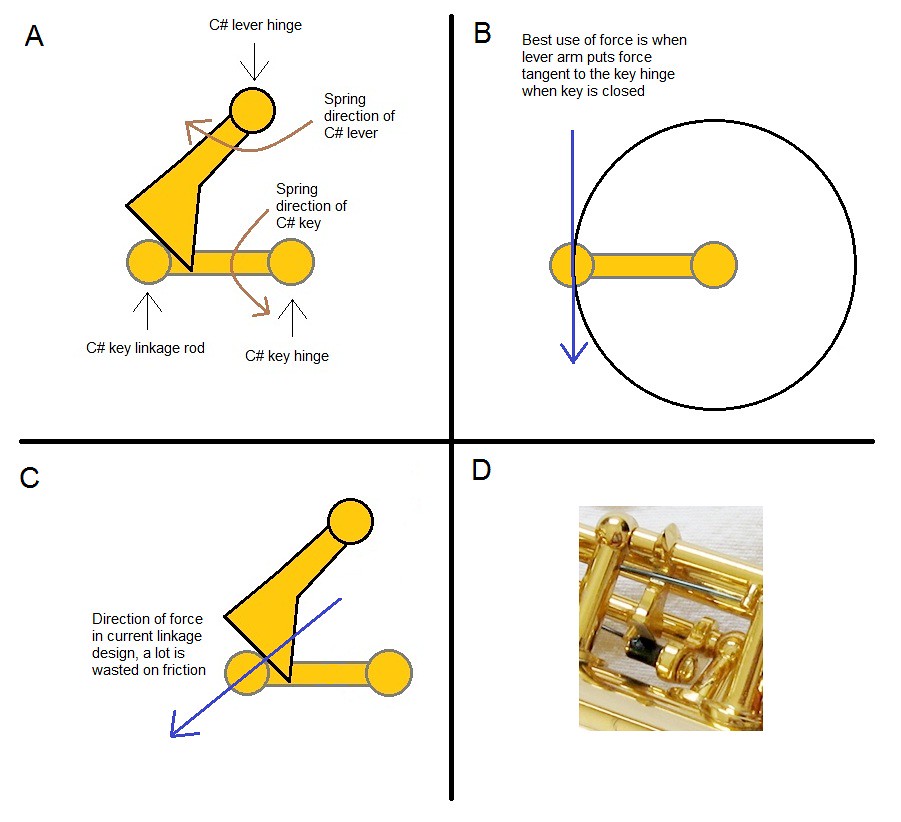A few people asked me about this recently and I decided to do a simple drawing to show this problem. Posted on SOTW so thought I'd post here too. I thought about posting this in the Saxophone Makes sub-forum but decided to post here... move it if it should be there. This is specific to the Borgani soprano low C# linkage, but this same issue exists in various linkages on many saxophones. The C# on the Borgani sopranos is possibly the worst I've seen.
This linkage design problem was on the first Borgani soprano I saw about six years ago and have been the same on every Borgani soprano I've seen since then, the last being about a year ago. I told Borgani about it some years ago and they replied and sounded interested but changed nothing so far AFAIK (unless they did in recent months).
(A) shows how the linkage works. Approximately how the hinges are in relation to each other, the linkage shapes, the spring directions, etc.
(B) shows how the lever should optimally be for the best use of force to close the key. The force direction should be tangent to the key hinge at the point when the key is closed.
(C) shows how the direction of force in this linkage. It is actually a little worse than this drawing shows...
(D) is a photo of the actual linkage on the instrument.
What this means is the C# lever spring is especially strong to make the C# key close, but even then it is borderline. This doesn't feel good to the player, very difficult to play C#. If the spring is made slightly less strong, the key will not close reliably (e.g. if the lever is released more slowly the key won't close) but this is still too strong for the player. If the C# key and C# lever springs are made to feel good like they should, the key won't close reliably at all.
The linkage needs to change so the direction of force is more like in (B). Some difference from exactly tangent is fine, it doesn't have to be perfect to feel excellent. There are a few ways to do that, but the easiest would be for Borgani to make it that way. It is not difficult and requires very little changes to the shape of the parts. The key side of the linkage should be soldered at a different angle, higher in comparison with the key cup. The lever side of the linakge should have a different shape. It's possible to repair it but that leaves some marks because grinding is necessary, though mostly behind glued material.

This linkage design problem was on the first Borgani soprano I saw about six years ago and have been the same on every Borgani soprano I've seen since then, the last being about a year ago. I told Borgani about it some years ago and they replied and sounded interested but changed nothing so far AFAIK (unless they did in recent months).
(A) shows how the linkage works. Approximately how the hinges are in relation to each other, the linkage shapes, the spring directions, etc.
(B) shows how the lever should optimally be for the best use of force to close the key. The force direction should be tangent to the key hinge at the point when the key is closed.
(C) shows how the direction of force in this linkage. It is actually a little worse than this drawing shows...
(D) is a photo of the actual linkage on the instrument.
What this means is the C# lever spring is especially strong to make the C# key close, but even then it is borderline. This doesn't feel good to the player, very difficult to play C#. If the spring is made slightly less strong, the key will not close reliably (e.g. if the lever is released more slowly the key won't close) but this is still too strong for the player. If the C# key and C# lever springs are made to feel good like they should, the key won't close reliably at all.
The linkage needs to change so the direction of force is more like in (B). Some difference from exactly tangent is fine, it doesn't have to be perfect to feel excellent. There are a few ways to do that, but the easiest would be for Borgani to make it that way. It is not difficult and requires very little changes to the shape of the parts. The key side of the linkage should be soldered at a different angle, higher in comparison with the key cup. The lever side of the linakge should have a different shape. It's possible to repair it but that leaves some marks because grinding is necessary, though mostly behind glued material.

